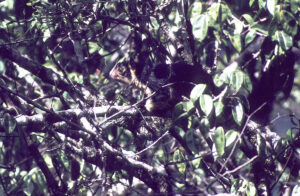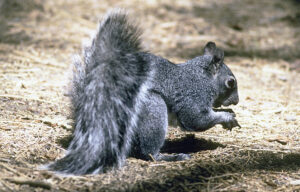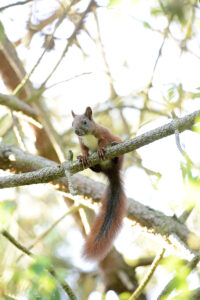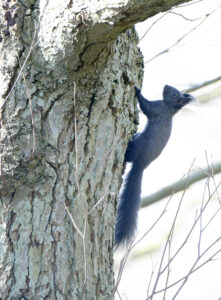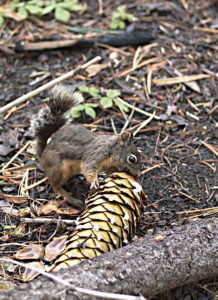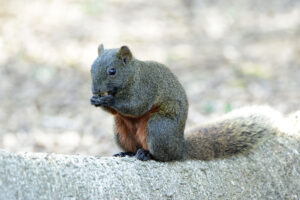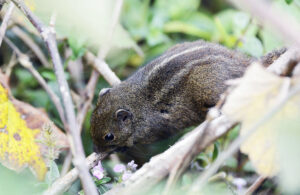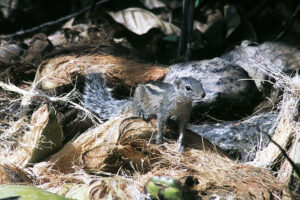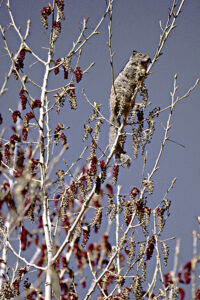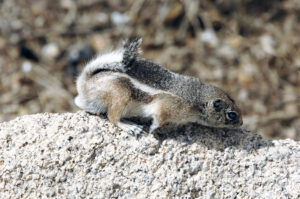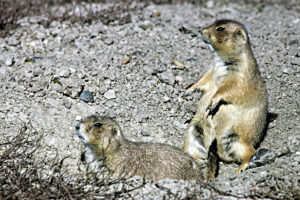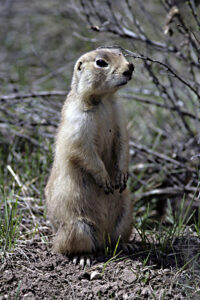Squirrels
Golden-mantled ground squirrel (Callospermophilus lateralis), sitting on a log in Yosemite National Park, California. (Photo copyright © by Kaj Halberg)
The black-tailed prairie dog (Cynomys ludovicianus) is the most numerous of the five species of prairie dog. This picture is from Badlands National Park, South Dakota. (Photo copyright © by Kaj Halberg)
Five-striped palm squirrel (Funambulus pennantii) with nesting material, Keoladeo National Park, Rajasthan, India. (Photo copyright © by Kaj Halberg)
In autumn, marmots (Marmota) have put on a thick layer of fat to sustain them during their long hibernation. This picture shows an alpine marmot (M. marmota), sitting outside its den, Gran Paradiso National Park, Italy. (Photo copyright © by Kaj Halberg)
Ratatosk is a squirrel,
Scurrying up and down the ash Yggdrasil,
To bring evil words
Between an eagle in the top
And the dragon Nidhug below.
From Grimnismál (‘Grimner’s Talk’), in the Poetic Edda, an untitled collection of Old Norse anonymous poems.
In Norse mythology, the squirrel Ratatosk brings news between the various worlds of the all-embracing tree Yggdrasil. He is scurrying up and down between the top of the tree and its roots to bring hateful words between two enemies, an eagle, which lives in the top, and a dragon, Nidhug, which lies next to the well Hvergelmir in the underworld Niflheim, gnawing on one of the three roots of Yggdrasil.
Yggdrasil is described in depth on the page Religion: Animism.
Ratatosk, illustrated in an Icelandic manuscript from the 1700s. The text says: ”Ratatoskur ber op undar ord myllu arnr og Nyðhoggs” (‘Ratatosk brings evil words between the eagle and Nidhug’). (Illustration: Public domain)
This wall painting in Kalø Hunting Cottage, Rønde, eastern Jutland, Denmark, shows Ratatosk and the eagle atop Yggdrasil. (Photo copyright © by Kaj Halberg)
“Capt Lewis & myself walked up to the top (…) discovered a village of small animals that burrow in the grown (those animals are called by the French Pitite Chien*.) Killed one & cought one alive by poreing a great quantity of water in his hole. We attempted to dig to the beds of one of thos animals, after diging 6 feet, found by running a pole down that we were not half way to his lodges. (…) Those little animals set erect (and) make a whistleing noise, and whin allarmed slip into their hole. (…) The toe nails (are) long, (and) they have fine fur.”
Captain William Clark’s diary, September 7, 1804, describing a colony of prairie dogs (Cynomys).
* ‘Little dog’
“The eldest son [out of 12 sons of the first people on Earth] was called Nangli Bondo. His tribe lived in happiness and prosperity. But one day Kidramati-Rani, the squirrel, said: “On Monday it will thunder, on Tuesday it will rain, on Wednesday the whole Earth will be covered by the waters. Eat all you can today, for there is going to be a long period of famine.“
Legend of the Bondo tribe, Odisha (Orissa), India, related in the book Primitive India (Harrap and Co., 1954), written by Polish-born French author Vitold de Golish (1921-2003).
Squirrels constitute a large family of rodents, Sciuridae, which contains 5 extant subfamilies with about 70 genera and almost 300 species, found on all continents except Australia and Antarctica. In Australia, however, some species have been introduced by humans.
The largest diversity of squirrels is found in tropical rainforests. Temperate Eurasia harbours only about 20 species, whereas the family is numerous and diverse in North America, numbering altogether about 84 species.
The word squirrel, which was in use as early as 1327, is derived from the Anglo-Norman name esquirel, which is again from the Old French escurel, a corruption of the Latin sciurus, which is derived from Ancient Greek skiuros, ultimately from skia (‘shadow’) and oura (‘tail’), thus ‘shadow-tailed’, alluding to the large, bushy tail of many squirrels. Some species have a habit of flicking their tail over their back, and in this way tropical species are able to use their tail as a protection against the fierce sunshine.
Squirrels are mainly vegetarians, but also eat various insects and other invertebrates, besides eggs and young of smaller birds. Larger squirrels are able to kill small mammals like mice, and a Mexican ground squirrel (Ictidomys mexicanus) was observed killing a young rabbit, which was almost a fourth of its own size. Cannibalism occurs in several species. Sometimes squirrels feed on dead animals.
Many squirrels living in cold areas hibernate during winter, and some even aestivate during the hottest part of the summer.
Dead squirrels should be handled with care, as their fleas can carry bubonic plague.
Below, a number of squirrel species, which I have managed to photograph around the world, are described. All subfamilies are represented, with the exception of Sciurillinae, which contains a single species, the neotropical pygmy squirrel (Sciurillus pusillus).
Ratufinae Oriental giant squirrels
This subfamily contains a single genus, Ratufa, with 4 species of large squirrels, distributed from India and Sri Lanka eastwards to Indochina and southern China, and thence southwards to Indonesia.
Ratufa indica Indian giant squirrel, Malabar giant squirrel
This species is endemic to India, found from Rajasthan and Bihar southwards to the southern Western Ghats, near the southern tip of India. It mainly lives in forests and woodlands in hilly areas. It is strictly arboreal, and most of its food consists of leaves, fruits, and seeds.
Indian giant squirrels, feeding on flowers of a silk-cotton tree (Bombax ceiba), Periyar National Park, Kerala. (Photo copyright © by Kaj Halberg)
This Indian giant squirrel is eating a fruit of a leguminous tree (Fabaceae), Azhiyar Ghat, Tamil Nadu. (Photo copyright © by Kaj Halberg)
This one is feeding on pulp of a species of breadfruit, Artocarpus hirsutus, Periyar National Park. (Photos copyright © by Kaj Halberg)
Ratufa macroura Grizzled giant squirrel
This species is found in southern India, along the Kaveri River and in the hill forests of Karnataka, Tamil Nadu, and Kerala, and in the major part of Sri Lanka.
Currently, 3 subspecies are recognized. Subspecies macroura is jet-black above, rump with grizzled appearance, underparts cream-coloured to pale yellow, tail black with a white tip. It is restricted to the central highlands of Sri Lanka, up to elevations around 2,000 m.
Subspecies dandolena is brown above, grizzled with white, underside brownish-cream, rump white, tail dark, frosted with white hairs, forehead and feet black. It is found in the dry zone of Sri Lanka, and in India.
Subspecies melanochra is jet-black above, underparts cream-coloured to orange-yellow, tail black, frosted with white hairs. It is distributed in the low-country wet zone of Sri Lanka, and in intermediate zones of the country.
The subspecies vary tremendously, even within a local population, so why it is divided into 3 subspecies is a reasonable question.
The specific name is derived from Ancient Greek makros, which, strictly speaking, means ‘long’, but is also translated as ‘large’; and oura (‘tail’), thus ‘large-tailed’.
Grizzled giant squirrel, ssp. dandolena, investigating a branch, Polonnaruwa, Sri Lanka. (Photo copyright © by Kaj Halberg)
Grizzled giant squirrel, ssp. melanochra, Nuwara Eliya, Sri Lanka. (Photo copyright © by Kaj Halberg)
Sciurinae
This subfamily is divided into two tribes, Sciurini and Pteromyini.
Sciurini Bushy-tailed squirrels
A tribe with c. 13 genera and about 38 species, found in Eurasia and the Americas.
Sciurus
A large genus with about 30 species, distributed in Europe, temperate areas of Asia, and the entire Americas.
An extensive genetic study from 2020 (Abreu et al. 2020) concludes that the genus is paraphyletic and should be split into 11 or 12 genera, leaving only 3 species in Sciurus. However, this suggestion has not been widely accepted, and for the time being I retain the older concept of the genus.
The generic name is explained at the top of this page.
Interestingly, the Grand Canyon constitutes a barrier between two subspecies of Abert’s squirrel (S. aberti), found on the Colorado Plateau. They are of similar size, with large bushy tails and long ear tufts – but their colouring is very different. Abert’s squirrel, ssp. aberti, which lives in coniferous forests south of the Grand Canyon, has white belly and grey tail, whereas the Kaibab squirrel, ssp. kaibabensis, found in a similar habitat north of the canyon, has black belly and white tail.
Sciurus carolinensis Eastern grey squirrel
This species, by some authorities called Neosciurus carolinensis, is among the most widespread of the North American squirrels, found in the eastern half of the continent, and has also been introduced to several areas in the West. It is very common in towns, as long as there are trees, where it can take shelter from dogs and other enemies.
These animals are active throughout the year, and in autumn they store nuts and fruits in underground caches. They are not able to remember where the food was buried, but find it by smelling it under the snow. Grey squirrels are often a nuisance on bird feeders, where they consume most of the food that was intended for birds. In parks and other places, where people regularly feed grey squirrels, they become very tame indeed.
The eastern grey squirrel has been successfully introduced to South Africa, Britain, and other places. In Britain, it is regarded as a pest, as it outcompetes the native Eurasian red squirrel (below), which is now scarce south of Scotland. Extermination campaigns of grey squirrels have been initiated in the U.K., causing the red squirrel to increase in several places.
The specific name refers to the Carolinas. Presumably, the type specimen was collected there.
Eastern grey squirrel, Kew Botanical Gardens, London. (Photo copyright © by Kaj Halberg)
Eastern grey squirrels are often a nuisance on bird feeders, where they consume most of the food, as in this picture from Long Island, New York. (Photo copyright © by Kaj Halberg)
Where people regularly feed eastern grey squirrels, they become very tame indeed, as these in Kew Botanical Gardens. (Photos copyright © by Kaj Halberg)
Despite its name, the pelt of this animal is often brownish, as on this specimen from Long Island. (Photo copyright © by Kaj Halberg)
Sciurus granatensis Red-tailed squirrel
This common species, by some authorities called Syntheosciurus granatensis, is found in Central America and north-western South America, from Costa Rica eastwards to Venezuela, and thence southwards to Ecuador, and also on the Caribbean islands Margarita and Trinidad & Tobago.
It lives in various types of forest, from sea level to an elevation of about 3,000 m. It is confiding and often occurs in picnic grounds.
The specific name refers to a Spanish enclave named Virreinato de Nueva Granada (‘The Viceroyalty of New Granada’) – an area, which in the 1700s covered present-day Panama, Columbia, Venezuela, and Ecuador.
Red-tailed squirrels, eating nuts at a viewing platform for tourists, Parque Nacional Volcán Poás, Cordillera Central, Costa Rica. (Photos copyright © by Kaj Halberg)
Sciurus griseus Western grey squirrel
“The California grey is one of the most beautiful, and, next to the Douglas, the most interesting of our hairy neighbors. Compared with the Douglas, he is twice as big, but far less lively and influential as a worker in the woods, and he manages to make his way through leaves and branches with less stir than his small brother. I have never heard him bark at anything except our dogs. When in search of food, he glides silently from branch to branch, examining last year’s cones, to see whether some few seeds may not be left between the scales, or gleans fallen ones among the leaves on the ground, since none of the present season’s crop is yet available. His tail floats now behind him, now above him, level or gracefully curled like a wisp of cirrus cloud, every hair in its place, clean and shining and radiant as thistle-down in spite of rough, gummy work.”
John Muir (1838-1914), Scottish-American writer and environmentalist, in his book My First Summer in the Sierra (1911).
This species, by some authorities called Hesperosciurus griseus, has a larger and bushier tail than the eastern grey squirrel (above). It is distributed in the Pacific States, from northern Washington southwards to southern California, just entering northern Baja California, Mexico.
The specific name is Latin, meaning ‘grey’.
Western grey squirrel, Yosemite National Park, California. (Photo copyright © by Kaj Halberg)
Sciurus niger Fox squirrel
This species, by some authorities named Parasciurus niger, is distributed in the eastern United States and south-eastern Canada, westwards to the Dakotas, Colorado, and Texas. The colour of the pelt varies tremendously. Western populations are mostly yellowish-brown, whereas those further east are darker, from dark brown to almost black.
The specific name is Latin, meaning ‘black’.
Some individuals of eastern populations of the fox squirrel are almost black, like this one, resting on a branch in Carolina Beach State Park, North Carolina. (Photo copyright © by Kaj Halberg)
Sciurus variegatoides Variegated squirrel
This common species, by some authorities named Echinosciurus variegatoides, is native from Mexico eastwards through Central America to Panama. Habitats include forest, secondary growth, and plantations, from the lowland up to an altitude of about 1,800 m. It is sometimes a pest in crops.
As the specific and popular names imply, the coat of this squirrel varies considerably, not only between the 15 subspecies, but also between individuals in the same population.
Variegated squirrel, Bagaces, Guanacaste, Costa Rica. (Photos copyright © by Kaj Halberg)
Sciurus vulgaris Eurasian red squirrel
Despite its name, the coat of this animal varies from bright rufous to black, not only between separate populations, but also within a single population. Regardless of the colour, the belly is always whitish.
This species is common and very widely distributed, from the major part of Europe eastwards across the Siberian taiga to the Kamchatka Peninsula, and thence along the Pacific coast southwards to north-eastern China, Korea, and the Japanese island Hokkaido. There are also scattered populations in Central Asia, and a separate population in the Caucasus.
The specific name is Latin, meaning ‘common’.
Red squirrel, Södra Greda, Öland, Sweden. (Photos copyright © by Kaj Halberg)
Rufous form, Mols, Denmark. (Photos copyright © by Kaj Halberg)
Dark brown form, eastern Jutland, Denmark. (Photos copyright © by Kaj Halberg)
Dark brown form, eastern Funen, Denmark. (Photo copyright © by Kaj Halberg)
Intermediate form, eating sunflower seeds, Møn, Denmark. (Photos copyright © by Kaj Halberg)
Tamiasciurus Pine squirrels
A genus of small, bushy-tailed squirrels, comprising 3 species, which are native to North America, from the major part of Canada southwards to north-western Mexico.
The generic name is composed of two other genus names, Tamias (chipmunks, see below) and Sciurus (above). The name refers to these squirrels being almost as small as chipmunks.
Tamiasciurus douglasii Douglas squirrel
“The Douglas squirrel is by far the most interesting and influential of the California Sciuridæ, surpassing every other species in force of character, numbers, and extent of range, and in the amount of influence he brings to bear upon the health and distribution of the vast forests he inhabits.”
John Muir (1838-1914), Scottish-American writer and environmentalist, in his book The Mountains of California (1894).
The Douglas squirrel “is the brightest of all the squirrels I have ever seen, at hot spark of life, making every tree tingle with his prickly toes, a condensed nugget of fresh mountain vigor and valor. (…) He seems to think the mountains belong to him, and at first tried to drive away the whole flock of sheep as well as the shepherds and dogs. How he scolds, and what faces he makes, all eyes, teeth, and whiskers! If not so comically small, he would indeed be a dreadful fellow. (…) The yellow pine cones (…) are held upside down on the ground by the Douglas squirrel, and turned around gradually until stripped, while he sits usually with his back to a tree, probably for safety. Strange to say, he never seems to get himself smeared with gum, not even his paws or whiskers.”
John Muir, in his book My First Summer in the Sierra (1911).
This squirrel is mainly restricted to old-growth coniferous forests along the Pacific Coast, from south-western British Columbia to the northern half of California.
The specific and common names honour Scottish gardener and botanist David Douglas (1799-1834), who explored the North American flora during three expeditions. He introduced many American trees, bushes, and herbs into British cultivation. In a letter to Sir William Jackson Hooker (1785-1865), director of the Botanical Gardens of Glasgow University, he wrote, “You will begin to think I manufacture pines at my pleasure.”
Douglas died under mysterious circumstances while climbing Mauna Kea in Hawaii in 1834. Apparently, he fell into a pit trap and was possibly crushed by a bull that fell into the same trap. He was last seen at the hut of Englishman Edward ‘Ned’ Gurney, a bullock hunter and escaped convict. Gurney was suspected to have caused Douglas’s death, as Douglas was said to have been carrying more money than Gurney subsequently delivered with the body. (Source: Nisbet 2009)
This Douglas squirrel is feeding on a cone of sugar pine (Pinus lambertiana), which is larger than itself, Yosemite National Park, California. (Photo copyright © by Kaj Halberg)
Tamiasciurus hudsonicus American red squirrel
Divided into about 25 subspecies, this animal has a very wide distribution, from Alaska across most of Canada to the north-eastern U.S., the Appalachians, and the Rocky Mountains, southwards to Arizona.
Presumably, the specific name refers to Hudson Bay.
American red squirrel, feeding on an acorn, Mackworth Island, Maine. (Photos copyright © by Kaj Halberg)
Pteromyini Flying squirrels
This tribe contains 15 genera and about 45 species, found in Eurasia, and North and Central America.
Despite their name, flying squirrels cannot really fly, but between their forelegs and hindlegs is a large fold of skin, which, when spread out, assists them in gliding from one tree to another. This skin fold contains muscles, making it possible for the squirrel to manoeuvre in the air.
Most species are strictly nocturnal, spending the daytime hours sleeping in their nest, which is often an abandoned woodpecker hole. Animals in cold areas do not really hibernate in the winter, but spend long periods being inactive, in order to save energy. The animals often huddle together to keep warm.
Petaurista Giant flying squirrels
This genus, comprising about 16 to 19 species of large flying squirrels, is found in forested habitats, from the Indian Subcontinent eastwards to Japan and Taiwan, and thence southwards through Indochina and Malaysia to Indonesia. The taxonomy of these animals is complicated and far from being clarified.
The generic name is derived from Ancient Greek petauristes (‘acrobat’), naturally alluding to the elegant gliding of these animals.
Petaurista albiventer White-bellied giant flying squirrel
This species is distributed from north-eastern Afghanistan eastwards along the Himalaya to Nepal, occurring at altitudes between 150 and 3,000 m. Its upperparts are reddish-chestnut with many whitish hairs, whereas the underside, throat, and cheeks are whitish. The tail is brown, often with a black tip.
Previously, it was regarded as a subspecies of the widespread red giant flying squirrel (P. petaurista). However, recent genetic research has split that species into a number of separate species. The white-bellied was also formerly reported eastwards to the Yunnan Province, but eastern Himalayan animals are now recognized as belonging to a recently described separate species, the Yunnan giant flying squirrel (P. yunanensis).
The specific name is derived from the Latin albus (‘white’) and venter (‘belly’).
In this picture, Indian forester B.P. Bahuguna shows a leaf of spiny-leaved oak (Quercus semecarpifolia), which has been partly eaten by a white-bellied giant flying squirrel. The squirrel always eats only part of the leaf, by folding it up and biting the central, less toxic part. – Asi Ganga Valley, Uttarakhand. (Photo copyright © by Kaj Halberg)
During a hike up the Asi Ganga Valley, we found many such leaves along the trail. This hike is related on the page Travel episodes – India 2008: Mountain goats and frozen flowers. (Photo copyright © by Kaj Halberg)
Callosciurinae Asian ornate squirrels and palm-squirrels
This subfamily is divided into two tribes, Callosciurini and Funambulini.
Callosciurini Asian ornate squirrels
A tribe with 13 genera and about 60 species.
Callosciurus
This genus contains about 15 species, found mainly in Indochina, Malaysia, and Indonesia, with a few species occurring in Nepal, northeastern India, Bangladesh, southern China, and Taiwan. Most species live in tropical rain forests, but some have adapted to a life in city parks and gardens. Their food consists of nuts, fruits, and seeds, and also insects and bird eggs.
The first part of the generic name is derived from the Greek kallos (‘beautiful’) – although many of the species are of a rather plain brown colour.
Callosciurus erythraeus Red-bellied squirrel, Pallas’s squirrel
This animal is widespread, found from eastern Nepal, Bhutan, and north-eastern India eastwards through Indochina and the Malayan Peninsula to southern China, and Taiwan. More than 30 subspecies have been described, although not all are recognized by many authorities.
The specific name is derived from Ancient Greek erythros (‘red’), alluding to the belly, which is often – but not always – reddish.
Red-bellied squirrel, subspecies taiwanensis, Taichung, Taiwan. This subspecies is common and widespread at lower elevations in Taiwan. (Photos copyright © by Kaj Halberg)
In these pictures, squirrels of subspecies taiwanensis are feeding on food, which has been put out for birds near a temple, dedicated to Confucius, in Tainan, southern Taiwan. This has caused these otherwise rather shy squirrels to have become remarkably tame. (Photos copyright © by Kaj Halberg)
Subspecies hendeei of the red-bellied squirrel is distributed in Indochina. It may be identified by its black feet. This one is searching for edibles on a palm trunk, Hanoi, Vietnam. (Photos copyright © by Kaj Halberg)
Callosciurus notatus Plantain squirrel
This is a common animal, found in a wide range of habitats, including forest, mangrove, parks, gardens, and agricultural areas. It is distributed from Indochina southwards through Malaysia to Indonesia.
The specific name is Latin, meaning ‘marked’. What it refers to is not clear.
This plantain squirrel was encountered in a plantation of oil palms (Elaeis guineensis), Bukit Peninjau, Sarawak, Borneo. (Photos copyright © by Kaj Halberg)
Callosciurus pygerythrus Hoary-bellied squirrel, Irrawaddy squirrel
This animal, comprising 7 subspecies, is found from eastern Nepal, north-eastern India, and Bangladesh eastwards to southern China. The name Irrawaddy squirrel is not very appropriate, as it is found in many other places than along the Ayeyarwaddy River, formerly called Irrawaddy by the British.
The fur of this animal varies greatly in colouration, according to subspecies, but upperside and tail are usually greyish-brown or reddish-brown, whereas the underside may be brownish, reddish, or whitish.
The specific name is derived from Ancient Greek pyge (‘rump’) and erythros (‘red’), alluding to the hind parts of the underside being reddish in some subspecies.
Hoary-bellied squirrels are often observed on ruins of Buddhist pagodas in Bagan, Myanmar. (Photos copyright © by Kaj Halberg)
Dremomys Red-cheeked squirrels
A small genus of 6 species, restricted to warmer areas of Asia, found from Nepal eastwards to China and Taiwan, and thence southwards through Indochina and Malaysia to Indonesia.
Dremomys lokriah Orange-bellied squirrel
This squirrel is brownish, with a bright orange underside. It is distributed in northern India, Nepal, Bhutan, Bangladesh, Myanmar, and southern China, living at elevations between 900 and 3,000 m. It is utilized for medicinal purposes by tribal people in north-eastern India.
The etymology of the specific name is not known, but probably some local Nepalese name of the species. It is known that some early authors, when describing new species, used local names as specific names, without explaining the etymology. One such author was British naturalist and ethnologist Brian Houghton Hodgson (1801-1894), who described this squirrel from Nepal in 1836. (Source: C. Srinivasulu 2018. South Asian Mammals: An updated Checklist and Their Scientific Names. CRC Press)
Orange-bellied squirrel, Manigaon, Trisuli Valley, central Nepal. (Photos copyright © by Kaj Halberg)
Tamiops Asiatic striped squirrels
These tiny squirrels, comprising 4 species, are distributed from the eastern Himalaya eastwards across Indochina to southern China and Taiwan. They resemble palm-squirrels (below), but have smaller, rounded ears with long, white-tipped hairs. Along the back, they have three pale stripes, bordered by dark brown fur.
The generic name is composed of the genus name Tamias (chipmunks, see below), and Ancient Greek opsis (‘appearance’), referring to the similarity of these squirrels to chipmunks.
Tamiops maritimus Maritime striped squirrel, eastern striped squirrel
This species is found in southern and eastern China, Taiwan, and in Laos and Vietnam east of the Mekong River. It is diurnal and strictly arboreal, feeding on fruits, seeds, nectar, and insects.
The specific name is not very appropriate, as this squirrel is mainly found in inland forests.
Maritime striped squirrel, subspecies formosanus, feeding on fruits of Chinese wonder tree (Idesia polycarpa), Dasyueshan National Forest, Taiwan. (Photos copyright © by Kaj Halberg)
Funambulini Palm-squirrels
There is only a single genus in this tribe, Funambulus, containing 6 species, restricted to the Indian Subcontinent and south-eastern Iran.
The generic name is derived from the Latin funis (‘rope’) and ambulo (‘to walk’), thus ‘rope-walker’, alluding to the agility of these animals.
Funambulus obscurus Dusky striped squirrel
This small squirrel is endemic to Sri Lanka, where it mainly lives in areas of high rainfall. Core areas include Sinharaja Forest in the south-western part of the island, and Maha Eliya Thenna National Park (Horton Plains) in the highlands, up to elevations around 2,400 m.
Previously, it was regarded as a subspecies of F. sublineatus in southern India, but was upgraded to a separate species in 2012.
The specific name is Latin, meaning ‘dark’ or ‘dusky’.
Dusky striped squirrel, Maha Eliya Thenna National Park (Horton Plains), Sri Lanka. (Photos copyright © by Kaj Halberg)
Funambulus palmarum Three-striped palm-squirrel
This species replaces the five-striped palm squirrel (below) in the southern half of the Indian Peninsula and in Sri Lanka. It is very common, also in urban areas. It closely resembles the five-striped palm-squirrel, but lacks the pale stripe along each side.
It has been introduced to Madagascar and surrounding islands, and to Australia, where it has become a minor pest.
Three-striped palm-squirrel, Madurai, Tamil Nadu, South India. (Photo copyright © by Kaj Halberg)
This three-striped palm-squirrel is eating offerings of rice flour, placed at a shrine in the Minakshi Hindu Temple, Madurai. (Photo copyright © by Kaj Halberg)
Three-striped palm-squirrel, feeding among discarded coconut husks, south-western Sri Lanka. (Photo copyright © by Kaj Halberg)
Funambulus pennantii Five-striped palm-squirrel
This squirrel is distributed from south-eastern Iran eastwards to Bangladesh, southwards to Karnataka and Andhra Pradesh. It is very common, even in metropoles like Delhi and Kolkata. It has also been introduced to New Guinea and many Pacific islands, and a population is found in the city of Perth, Australia, established from zoo escapes.
The specific name is derived from Ancient Greek pente (‘five’), like the common name referring to 5 whitish stripes, 3 that divide the dark brown fur on the back into 4 parts, and one stripe along each side, slightly paler than the underside.
The five-striped palm-squirrel is ubiquitous in North Indian cities. This picture is from Jaisalmer, Rajasthan. (Photo copyright © by Kaj Halberg)
Five-striped palm-squirrels on acacia trunks, Keoladeo National Park, Rajasthan. (Photos copyright © by Kaj Halberg)
This five-striped palm-squirrel is eating fig fruits (Ficus), Sariska National Park, Rajasthan. (Photo copyright © by Kaj Halberg)
This one is eating the husk of a fruit from a tree, Mehrangarh Fort, Jodhpur, Rajasthan. (Photo copyright © by Kaj Halberg)
A confiding five-striped palm-squirrel, eating from the hand, Keoladeo National Park. (Photo copyright © by Kaj Halberg)
This one is eating a bisquit, presented by a tourist, Keoladeo National Park. (Photos copyright © by Kaj Halberg)
Xerinae Terrestrial squirrels
As the common name implies, members of this subfamily are almost exclusively terrestrial, although a few do climb trees. It is divided into three tribes, Xerini, Protoxerini, and Marmotini.
Xerini Spiny squirrels
This tribe contains 5 genera with 6 species, 5 of which are found in Africa, and the remaining one in Central Asia.
Geosciurus African ground squirrels
This genus, comprising two species, is found in drier parts of southern Africa, from South Africa northwards to Botswana and Namibia. These squirrels were previously included in the genus Xerus.
The generic name is composed of Ancient Greek geo- (‘of the earth’), and the genus name Sciurus, thus ‘ground squirrel’.
Geosciurus inauris South African ground squirrel
A widespread species in southern Africa, found in Namibia, Botswana, South Africa, and Lesotho. It is absent from coastal regions, living in grasslands and semi-desert.
This animal is also known as Cape ground squirrel, which is misleading, as it is not restricted to the Cape Province.
The specific name is Latin, meaning ‘ear-ring’. Presumably, it refers to the ears of this squirrel being very small and pointing out at a ninety-degree angle, thus resembling ear-rings.
South African ground squirrels outside their den, Kalahari Gemsbok National Park, South Africa. (Photos copyright © by Kaj Halberg)
South African ground squirrel, eating a seed, Kalahari Gemsbok National Park. (Photo copyright © by Kaj Halberg)
Protoxerini
A tribe with 6 genera and about 30 species, living in Africa.
Paraxerus African bush squirrels
This genus contains about 11 species, restricted to Africa.
The generic name is composed of Ancient Greek para (‘next to’ or ‘near’), and Xerus, the former name of the genus Geosciurus (above), presumably indicating that these squirrels are closely related to, or resembling, members of that genus.
Paraxerus cepapi Smith’s bush squirrel
Ten subspecies of this widely distributed squirrel have been described. It is found from southern Angola and northern Namibia eastwards to the Indian Ocean, and from western Tanzania and south-eastern Zaire southwards to south-eastern Botswana, north-eastern South Africa, and Mozambique. One characteristic is the white markings around the eyes.
The common name commemorates Scottish surgeon, explorer, ethnologist, and zoologist Andrew Smith (1797-1872), who undertook several expeditions in southern Africa 1822-1836.
Smith’s bush squirrel, Chief’s Island, Okawango, Botswana. (Photo copyright © by Kaj Halberg)
Smith’s bush squirrel, McIlwaine Game Park, Lake Chivero, Zimbabwe. (Photo copyright © by Kaj Halberg)
Smith’s bush squirrel, looking for tidbits on a table in a camp ground, Hwange National Park, Zimbabwe. (Photo copyright © by Kaj Halberg)
Marmotini Ground squirrels, chipmunks, prairie dogs, and marmots
A large tribe with about 15 genera and c. 90 species, found in Eurasia and North America.
Spermophilus Old World ground squirrels, sousliks
Genetic research has caused this formerly large genus to be split into several genera. Today it contains about 16 species, distributed in eastern Europe, the Middle East, and northern and central Asia.
The generic name is derived from the Greek sperma (‘seed’) and philos (‘fond of’), thus ‘fond of seeds’. The name souslik is derived from the Russian name of these animals, suslik.
Spermophilus citellus European ground squirrel, European souslik
This animal is distributed in two areas of eastern Europe, divided by the Carpathian Mountains. It is found from southern Poland and north-western Czech Republic southeast to western Romania and northern Serbia, and from southern Ukraine southwards through eastern Romania and Bulgaria to the Balkans (where it has a spotted occurrence), the European part of Turkey, and the extreme north-western tip of Asia Minor.
It is active during the day, living in colonies, in burrows dug into grassy areas. The animals in a colony take turns as sentinels, emitting a sharp whistle in case of danger, which makes all members scurry back to safety in the burrows. It hibernates for many months between autumn and early spring, the length of time depending on the local climate.
Presumably, the specific name is also derived from the Russian suslik. It is generally translated as ‘ground squirrel’.
European ground squirrels, eating outside their den, near Katerini, Greece. (Photo copyright © by Kaj Halberg)
Spermophilus xanthoprymnus Anatolian ground squirrel, Anatolian souslik
This species is largely restricted to inland Turkey, just reaching Armenia and Iran at the eastern limit of its distribution area.
The specific name is derived from Ancient Greek xanthos (‘yellow’) and prymnos (‘underside’), alluding to the yellowish belly of this animal.
Anatolian ground squirrel at its den, Karaman, Turkey. (Photos copyright © by Kaj Halberg)
Callospermophilus
This genus contains only 3 species, found in western North America and Mexico. In former days, these animals were included in the genus Spermophilus (above).
The generic name is derived from the Greek kallos (‘beautiful’), sperma (‘seed’), and philos (‘fond of’), thus ‘the beauty that loves seeds’ – an appropriate name, as the two North American species are certainly among the most beautiful squirrel species in the world.
Callospermophilus lateralis Golden-mantled ground squirrel
This beautiful squirrel is common in western North America, distributed from British Columbia and Alberta southwards through the western United States to California, Arizona, and New Mexico, eastwards to the Rocky Mountains.
The specific name is Latin, meaning ‘of the side’. This is puzzling, as the side of this species is greyish, whereas the beautiful stripes is down the back. However, it may refer to the golden-brown sides of the head.
Golden-mantled ground squirrel, Bend, Oregon. (Photos copyright © by Kaj Halberg)
Golden-mantled ground squirrel, eating a twig, Yosemite National Park, California. (Photos copyright © by Kaj Halberg)
Otospermophilus
This is a small genus of ground squirrels, comprising 3 species, which live in western United States and north-western Mexico. They were previouisly included in the genus Spermophilus (above).
The generic name is derived from Ancient Greek ot, the stem of ous (‘ear’), sperma (‘seed’), and philos (‘fond of’), thus ‘the eared one that loves seeds’. It seems that Prussian zoologist Johann Friedrich von Brandt (1802-1879), who named the genus in 1844, found that its members had rather large ears. He was mainly working in Russia, exploring parts of Siberia.
Otospermophilus beecheyi California ground squirrel
This animal is found from southern Washington southwards through Oregon and California into northern Baja California, and also in north-western Nevada. It is quite common and may easily be observed, sitting on its haunches keeping a lookout for enemies like coyotes, hawks, and eagles.
It was named in honour of English naval officer, artist, explorer, and writer Frederick William Beechey (1796-1856), who undertook several expeditions along the west coasts of North and South America.
California ground squirrel is common in Yosemite National Park, where these pictures were taken. (Photos copyright © by Kaj Halberg)
From a coastal rock in Point Lobos State Natural Reserve, this California ground squirrel is scanning its surroundings. (Photo copyright © by Kaj Halberg)
California ground squirrel, resting on a rock in Fern Canyon, Redwood National Park, California. (Photo copyright © by Kaj Halberg)
Otospermophilus variegatus Rock squirrel
This is a common species throughout its extensive range, stretching from Nevada, Utah, and Colorado southwards through eastern California, Arizona, New Mexico, and Texas to the state of Puebla, central Mexico.
It lives in semi-arid areas, from the lowlands to an altitude of about 2,900 m. As its name implies, it is mainly found in rocky areas, including cliffs and canyons, and also rock walls, bridges, and old houses in urban areas.
These animals rarely climb trees, living in burrows in colonies, ruled by a dominant male, which has several subordinate females. The diet includes fruit, seeds, nuts, insects, and earthworms. They will also sometimes eat meat. (Source: nationalgeographic.org/media/photo-ark-rock-squirrel)
This species is quite variable, a fact that is reflected in its specific name.
Rock squirrel in a typical habitat, at the edge of the abyss of the Grand Canyon, Arizona. (Photos copyright © by Kaj Halberg)
Have you got a peanut for me? – Tourists often feed the rock squirrels at Grand Canyon. (Photo copyright © by Kaj Halberg)
Occasionally, rock squirrels climb trees. This one is eating flowers of a cottonwood tree (Populus), Canyon de Chelly National Monument, Arizona. (Photo copyright © by Kaj Halberg)
Urocitellus
This genus, comprising about 14 species of ground squirrels, is native to western North America, with the exception of the arctic ground squirrel (below), which is also found in eastern Siberia.
Previously, they were included in the genus Spermophilus (above).
Presumably, the generic name is derived from Ancient Greek oura (‘tail’), and citellus (see Spermophilus citellus above), thus ‘tailed ground squirrels’ – an odd name, as all ground squirrels have a tail.
Urocitellus beldingi Belding’s ground squirrel
This species is found in montane areas of eastern California and Oregon, southern Idaho, and northern Nevada, living mainly at elevations between 2,000 and 3,600 m.
At higher altitudes, these animals may hibernate for as much as eight months a year. They emerge when snow is still covering the ground, looking for mates. After mating, they feed voraciously. Larger males may even kill newly emerged young squirrels and feed on them. Before they again start hibernating, by late August, their weight may have doubled.
The specifc name was applied by American zoologist and anthropologist Clinton Hart Merriam (1855-1942), whose description was based on a specimen sent to him by American ornithologist Lyman Belding (1829-1917), collected in the Sierra Nevada Mountains, California. Merriam writes: “I take pleasure in naming it in honor of its discoverer, Mr. L. Belding, of Stockton, California, whose contributions to the knowledge of the zoology of the region, particularly its ornithology, entitle him to lasting remembrance.”
Belding’s ground squirrel at its den, Carson Pass, California. (Photos copyright © by Kaj Halberg)
Urocitellus parryii Arctic ground squirrel
This common species is distributed in northern Canada, from Hudson Bay westwards to Alaska, and thence southwards to British Columbia, and also in the easternmost part of Siberia, southwards to the Kamchatka Peninsula. It mainly lives in tundra, but has also adapted to a life in towns in eastern Siberia. It is much hunted by Arctic peoples for food, and the pelt is used to line parkas.
The specific name honours English Royal Navy officer, explorer, and naturalist William Edward Parry (1790-1855), best known for his expedition 1819-1820 through the Parry Channel, the most successful in the long quest for the Northwest Passage. In 1827, he attempted one of the earliest expeditions to the North Pole, reaching 82°45′ N, a new record.
The arctic ground squirrel is common in the Chukotka Peninsula, eastern Siberia, where these pictures were taken. I often encountered animals living in abandoned pipes. (Photo copyright © by Kaj Halberg)
Ammospermophilus Antelope squirrels
Five species of these small ground squirrels are distributed in the south-western United States and northern Mexico, mainly living in desert areas. They are active during the day, but instead of getting rid of excess heat by evaporating precious water, they in fact store the heat in their body – they get fever! Only if their body temperature exceeds 45oC, will they move underground to cool off.
These animals all have brownish-whitish fur, with a white stripe along the flanks.
The generic name is derived from the Greek ammos (‘sand’), sperma (‘seed’), and philos (‘fond of’), thus ‘the sand-living (animal), which is fond of seeds’. The common name was given in allusion to their habit of flashing the white underside of their tail as a warning signal to other squirrels in case of danger – similar to the pronghorn (Antilocapra americana), also known as American antelope, which flashes its white fur on the rump in case of danger.
Ammospermophilus leucurus White-tailed antelope squirrel
This is the most widespread of the five species within this genus, found from southern Oregon southwards through eastern California to the entire Baja California Peninsula, eastwards to western Colorado, northern Arizona, and north-western New Mexico. It can be identified by the reddish fur on its limbs.
The specific name is derived from the Greek leukos (‘white’) and oura (‘tail’).
White-tailed antelope squirrel, Joshua Tree National Park, California. (Photos copyright © by Kaj Halberg)
Ammospermophilus harrisii Harris’s antelope squirrel
This animal is found in Arizona and New Mexico in the United States, and in the state of Sonora in Mexico. It is darker than the white-tailed antelope squirrel, and the legs are brown, not reddish.
It was named in honour of farmer, philanthropist, and naturalist Edward Harris (1799-1863), who accompanied the famous bird painter John James Audubon, born Jean-Jacques Rabin (1785-1851), on two of his expeditions.
Harris’s antelope squirrel, Tucson Mountain Park, Arizona. (Photo copyright © by Kaj Halberg)
Chipmunks
Formerly, all 25 species of the tiny chipmunks were placed in one genus, Tamias, but with the exception of the eastern chipmunk (below) and the Siberian chipmunk (Eutamias sibiricus), all species have now been moved to the genus Neotamias. Incidentally, the Siberian chipmunk is the only member of the group found outside America.
Of the 24 North American species, only two, the eastern and the least (Neotamias minimus), are found in the eastern half of the continent, whereas the rest are distributed in a variety of habitats in the West, many having a rather limited distribution.
All chipmunks have white and black (or dark brown) stripes in their face, and along the back are five dark and four white stripes. Their cheek pouches are very large.
The generic name Tamias is a Greek word, meaning ‘house-keeper’, or ‘storer’, referring to the habit of these animals to deposit nuts and other seeds in several underground caches in order to have a supply of food, should they wake up during the winter, and also when they emerge early in spring. One such cache contained 6 kilograms of food, including 3,000 hazelnuts and c. 1.5 kilos of wheat kernels. The prefix neo- is from the Greek neos, meaning ‘new’.
The common name was originally spelt chitmunk, from a native Ojibwa word, ajidamoo or ajidamoonh, meaning ‘one who descends trees headlong.’
Tamias striatus Eastern chipmunk
As described above, the eastern chipmunk is now the sole member of the genus Tamias. It is distributed in south-eastern Canada and the eastern half of the United States, except Florida.
Eastern chipmunk, resting at the entrance to its nesting hole, Wildwood State Park, Long Island, New York. (Photo copyright © by Kaj Halberg)
Neotamias amoenus Yellow-pine chipmunk
This species is widely distributed in western North America, from British Columbia southwards to northern and eastern California, northern Nevada, and northern Utah, eastwards to western Montana and Wyoming. It lives at higher elevations, between 1,000 and 2,900 m.
The specific name is Latin with several meanings, including charming, pleasant, delightful, and beautiful.
Yellow-pine chipmunk, feeding on a pine cone, Bend, Oregon. (Photos copyright © by Kaj Halberg)
Neotamias minimus Least chipmunk
This tiny species has a very wide distribution, found in most of Canada (except Arctic areas), around the Great Lakes, and in the western half of the United States.
Least chipmunk, Black Hills, South Dakota. (Photo copyright © by Kaj Halberg)
Neotamias speciosus Lodgepole chipmunk
This handsome chipmunk is found in the Sierra Mountains of eastern California, with isolated populations in the San Bernardino and San Jacinto Mountains near Los Angeles.
As its name suggests, this animal lives in forests that contain lodgepole pines (Pinus contorta), along with other pine species. It is omnivorous, eating leaves, flowers, pollen, seeds, small mammals, birds, bird eggs, and insects.
The specific name is from the Latin species (‘appearance’) and -osus, an ending which forms adjectives. In this connection, it may be translated as ‘handsome’ or ‘showy’, probably alluding to the reddish colour along the sides of this animal.
Lodgepole chipmunk, sitting on a tree stump, Yosemite National Park, California. (Photo copyright © by Kaj Halberg)
Neotamias townsendii Townsend’s chipmunk
This animal lives in forests along the Pacific Northwest, from extreme southern British Columbia southwards through western Washington and Oregon. It is omnivorous, eating a variety of plants and insects, and also bird eggs. In the late summer, the diet mainly consists of various berries, and later they eat acorns, huckleberries, grass, roots, and various seeds.
The specific name was given in honour of American naturalist and collector John Kirk Townsend (1809-1851), who participated in an expedition to the Northwest 1834-1835, led by Nathaniel Jarvis Wyeth (1802-1856). On his return, Townsend wrote The Narrative of a Journey across the Rocky Mountains to the Columbia River and a Visit to the Sandwich Islands (1839).
Feeding Townsend’s chipmunk, Umpqua Dunes, Oregon. (Photo copyright © by Kaj Halberg)
A confiding Townsend’s chipmunk takes food from a trekker’s hand, Garibaldi Provincial Park, British Columbia. (Photo copyright © by Kaj Halberg)
This golden retriever was watching a confiding Townsend’s chipmunk for a long time, then sniffed it without harming it. – Reedsport, Oregon. (Photo copyright © by Kaj Halberg)
Cynomys Prairie dogs
In 1803, American President Thomas Jefferson (1743-1826) ordered two army captains, Meriwether Lewis (1774-1809) and William Clark (1770-1838), to undertake an expedition across the western part of the North American continent, from the Mississippi River to the Pacific Ocean.
The main purposes of this journey were to describe this vast area, which was unknown to the white man in those days, and to find an easy access to the west coast, which would make it easier to open the area to trade and settlement.
During their three-year long expedition, Lewis described countless plants and animals, many of which were new to science. Various items were sent to President Jefferson in Washington, including a box, which contained a small animal that the two captains had encountered on the prairie. They learned that French settlers called this animal petite chien (‘little dog’), because to them the warning call of this animal sounded like a barking dog. Consequently, the box was labelled, “Wild dog of the prairie.”
Prairie dogs, however, are not at all dogs, but a type of ground squirrel. Their warning call is indeed slightly reminiscent of a barking dog, and when they sit on their haunches outside their den, keeping a lookout for enemies, they do look a bit like a little, fat dog.
The generic name means ‘dog mouse’ in the Greek. There are five species, of which the commonest is the black-tailed (below). Like the Mexican prairie dog (C. mexicanus), it has a black tip to the tail. The three remaining species, white-tailed (C. leucurus), Utah (below), and Gunnison’s (C. gunnisoni), all have white tip to the tail. Apart from the Utah prairie dog, these animals do not hibernate, but may undergo a mild stupor for a few days at a time during harsh winter weather.
Unique ecosystem
Prairie dogs live in large underground colonies on the prairie, popularly called ‘prairie dog towns’. Each family has several entrances to their ‘apartment’. These entrances are at different levels, causing an air current to flow through the tunnels, which will supply fresh oxygen to the animals.
Their diet consists of grasses and various herbs, and each animal consumes more than twice its own weight every month. They also eat insects and other invertebrates, and research has revealed that no less than 39% of young prairie dogs fall victim to cannibalism.
Prairie dog droppings deliver nutrients for a number of plant species to grow, and many larger herbivores benefit from this, including the American bison (Bos bison) and the pronghorn. Prairie dogs fall prey to various carnivores and raptors, including bobcat (Lynx rufus), coyote (Canis latrans), American badger (Taxidea taxus), kit fox (Vulpes macrotis), eagles, prairie falcon (Falco mexicanus), and ferruginous hawk (Buteo regalis).
The black-footed ferret (Mustela nigripes) is a mustelid, which used to be common in prairie dog towns, feeding on the squirrels in their underground tunnels. By 1970, it was feared that this interesting animal had become extinct. However, a small population was found in Wyoming in 1981, and since then, through captive breeding, its numbers have increased tremendously. It has been released in the wild at a number of locations, and seems to thrive, so it may still be possible to save this unique animal.
The small burrowing owl (Athene cunicularia) also depends on the prairie dog towns to provide nesting holes.
Thus, prairie dogs create a unique ecosystem.
Declining populations of prairie dogs
Formerly, prairie dogs were unbelievably numerous. Towards the end of the 19th Century, a population of five billion was estimated, the largest prairie dog towns covering tens of thousands of square kilometres. Following the arrival of European settlers, most of the prairie was cultivated, or utilized for grazing, and prairie dogs were regarded as a pest, as they would undermine the fields, eat the crops, and compete with cattle for fodder. Farmers began a large-scale eradication of prairie dogs, using diverse methods like poison, dynamite, drowning, shooting, gassing, and spreading of contagious diseases.
A hundred years later, prairie dog numbers were down by more than 90%, and today only scattered populations exist.
The status of black-tailed and Utah prairie dogs is described below. The populations of white-tailed and Gunnison’s are declining, and both species are regarded as vulnerable. The Mexican prairie dog is endemic to north-central Mexico, found only in the states of Coahuila and San Luis Potosi, formerly also occurring in Nuevo Leon and Zacatecas. The present number of this species is unknown, but its total area of distribution is less than 600 km2, and it is threatened with extinction.
Cynomys ludovicianus Black-tailed prairie dog
Although it has declined drastically, this species is still fairly common, distributed from Montana and North Dakota southwards to eastern New Mexico and western Texas, and the northern part of the Mexican state Chihuahua.
By far the largest colony is in the Janos Region of Chihuahua, where hundreds of thousands of animals survive, although their numbers are declining, mainly due to increasing cultivation of the area.
The specific name, which is the Latin form of Ludwig or Louis, refers to Captain Meriwether Lewis (1774-1809) of the famous Lewis and Clark expedition 1804-1806 (see above), when this prairie dog was first collected for science.
Black-tailed prairie dogs outside their den, Badlands National Park, South Dakota. (Photo copyright © by Kaj Halberg)
Sitting on its haunches outside its burrow in Badlands National Park, keeping a lookout for enemies, this black-tailed prairie dog does indeed look a bit like a little fat dog. (Photo copyright © by Kaj Halberg)
Female black-tailed prairie dog with young outside their den, Tucson Desert Zoo, Arizona. Research has revealed that no less than 39% of young prairie dogs fall victim to cannibalism. (Photos copyright © by Kaj Halberg)
Young black-tailed prairie dog, grooming its mother, Devils Tower National Monument, Wyoming. (Photo copyright © by Kaj Halberg)
Cynomys parvidens Utah prairie dog
The Utah prairie dog lives at higher altitudes than other prairie dogs, between 1,500 and 2,700 m. It hibernates about six months of the year – the only species of prairie dog to hibernate.
This species has declined drastically, and today it is restricted to an area of about 1,850 km2 in southern Utah. Although its numbers have been rising in the last few decades, the total number is less than 10,000, and it is still being regarded as threatened.
The specific name is derived from the Latin parvus (‘small’) and dens (‘tooth’), thus ‘small-toothed’.
This Utah prairie dog is sitting outside its burrow in Bryce Canyon National Park, Utah, its snout and paws muddy from ‘spring cleaning’. (Photo copyright © by Kaj Halberg)
Marmota Marmots
Marmots are large, ground-living squirrels, comprising 15 species, which occur in Europe, Asia, and North America. They are the largest and fattest of squirrels, growing up to 60 cm long and weighing up to 7 kg.
Marmots live in burrows up to 2 m underground, digging tunnels up to 10 m long. They often sit on their haunches outside their burrow, and their shrill warning whistles can be heard far away. Marmots are almost exclusively vegetarians. They do not make food deposits, but in autumn they have become extremely fat, and hibernate throughout the winter.
Arctic hunters kill many hoary marmots (M. caligata) and Alaskan marmots (M. broweri), eating their delicious meat and using their soft underfur to make parkas.
The generic name is a corruption of the Latin muris montanus (‘mountain mouse’).
Marmota marmota Alpine marmot
This is a common animal, living in alpine areas at elevations between 800 and 3,200 m, in southern France, the Vosges, the Black Forest, the Alps, the northern Apennines, the Carpathians in Romania, and the Tatras in Poland. In 1948, it was reintroduced with success in the Pyrenees, where it had disappeared at end of the last Ice Age.
Alpine marmot, sitting at the entrance to its den, Gran Paradiso National Park, Italy. (Photo copyright © by Kaj Halberg)
This one is collecting grass, Gran Paradiso National Park. (Photo copyright © by Kaj Halberg)
Alpine marmot, basking in the sun, Vallee de Heas, Pyrenees, France. (Photos copyright © by Kaj Halberg)
Marmota flaviventris Yellow-bellied marmot
This species is native to montane areas, typically living above 2,000 m. It is distributed from the extreme southern parts of south-western Canada southwards to eastern California, and thence eastwards to the Rocky Mountains. Despite its specific name, which is Latin for ‘yellow-bellied’, the belly of this animal is not really yellow, but the upper breast and an area, stretching from the forelegs to behind the ears, is a rich yellowish-brown.
In the days of Scottish-American writer and environmentalist John Muir (1838-1914), the yellow-bellied marmot was regarded as the same species as the lowland woodchuck, or groundhog (M. monax), which is found in forests in the eastern and northern parts of the continent.
In his book My First Summer in the Sierra, published in 1911, Muir writes: “The (marmot) of the bleak mountains is a very different sort of mountaineer – the most bovine of rodents, a heavy eater, fat, aldermanic in bulk and fairly bloated, in his high pastures, like a cow in a clover field. One woodchuck would outweigh a hundred chipmunks, and yet he is by no means a dull animal. In the midst of what we regard as storm-beaten desolation he pipes and whistles right cheerily, and enjoys long life in his skyland homes.”
Yellow-bellied marmot, resting on a rock, Sequoia National Park, California. (Photos copyright © by Kaj Halberg)
Marmota himalayana Himalayan marmot
This species lives in grassy areas above the tree line, at altitudes between 3,000 and 5,500 m. It is found from the northern outskirts of the Himalaya, from northern Pakistan eastwards to the Sichuan and Yunnan Provinces, northwards across the Tibetan Plateau to Xinjiang, Qinghai, and Gansu.
A Himalayan marmot surveys its domain among lichen-covered boulders, blending very well with its surroundings, Nimaling, Upper Markha Valley, Ladakh. (Photos copyright © by Kaj Halberg)
Near Lake Tso Moriri, Ladakh, a colony of Himalayan marmots has found a peaceful haven. The local Buddhist people do not harm them, and they show no fear of people passing by. (Photos copyright © by Kaj Halberg)
Himalayan marmot, enjoying the morning sun, Tso Kar, Ladakh. (Photo copyright © by Kaj Halberg)
Sources
iucnredlist.org, the IUCN Red List of Threatened Species, 2017: Cynomys gunnisoni, C. leucurus, C. mexicanus, C. parvidens.
naturalhistory.si.edu/mna/image_menu.cfm?family=33
Wikipedia, various pages.
Abreu-Jr., E.F., S.E. Pavan, M.T.N. Tsuchiya, D.E. Wilson, A.R. Percequillo & J.E. Maldonado 2020. Museomics of tree squirrels: a dense taxon sampling of mitogenomes reveals hidden diversity, phenotypic convergence, and the need of a taxonomic overhaul. BMC Evolutionary Biology 20, article no. 77.
Macdonald, D. (red.) 1984. The Encyclopedia of Mammals. Facts on File.
Nisbet, J. 2009. The Collector: David Douglas and the Natural History of the Northwest. Sasquatch Books.
Srinivasulu C. 2018. South Asian Mammals: An updated Checklist and Their Scientific Names. CRC Press.
Truett, J.C., D.P. Gober, A.E. Ernst, R. List, H. Whitlaw, C.L. Hayes, G. Schmitt & W.E. van Pelt 2014. Prairie Dogs in the Chihuahuan Desert: History, Ecology, Conservation. In: C.A. Hoyt & J. Karges (eds.). Proceedings of the Sixth Symposium on the Natural Resources of the Chihuahuan Desert Region, October 14-17, 2004, pp. 211-240. The Chihuahuan Desert Research Institute, Fort Davis, Texas.
Whitaker, J.O. 1980. The Audobon Society Field Guide to North American Mammals. Alfred A. Knopf.
(Uploaded March 2021)
(Latest update December 2024)











